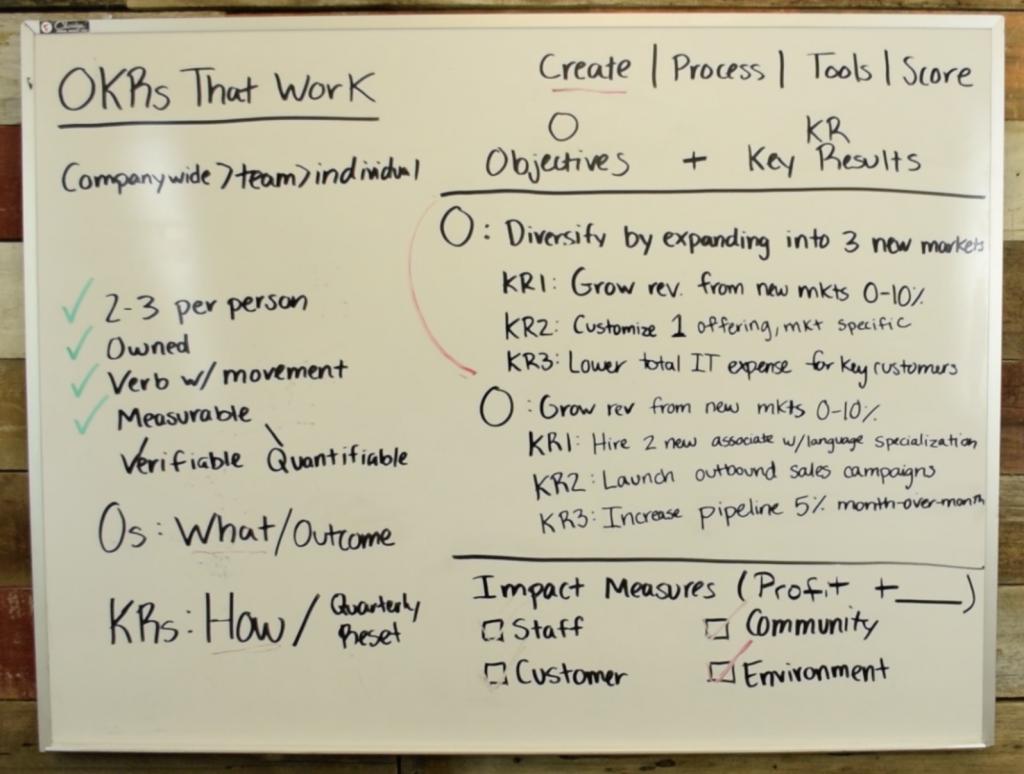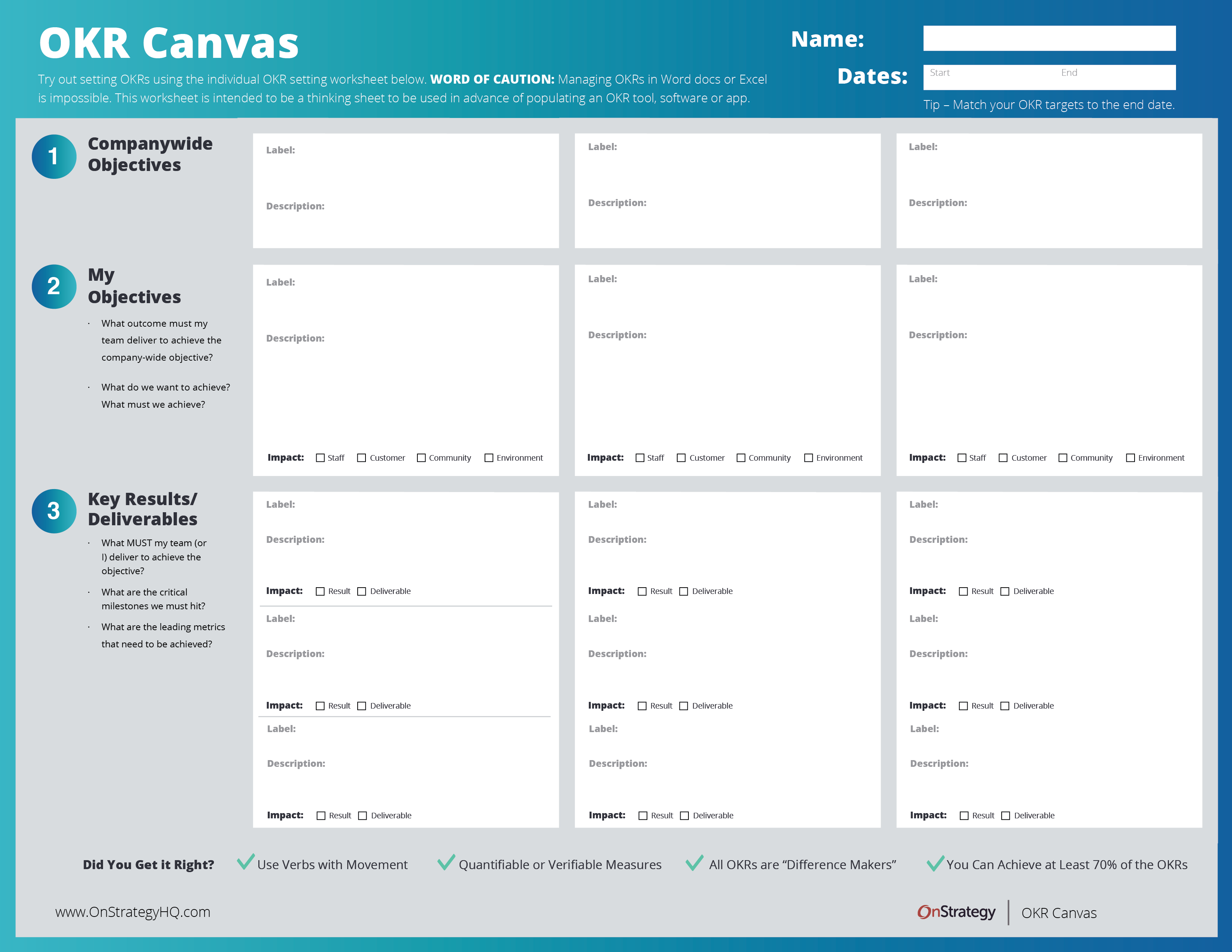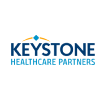OKRs (Objectives and Key Results) are a powerful and effective framework to use in your strategic planning process. However, it’s easy for your team to turn OKRs into a big, tangled mess that isn’t aligned to your direction. This is why it’s important to learn how to cascade OKRs.
Cascading OKRs is an important aspect to OKR development. In this article and 7-minute video, learn to create and cascade OKRs by aligning goals with measurable outcomes that move through different teams in your organization.

Video Transcript – Cascading OKR Best Practices
Hi, everyone, I’m Erica Olsen from OnStrategy. Welcome to our Whiteboard Series on OKRs that work. Today we’re going to talk about how to cascade OKRs through your organization. The first video we did is an overview of OKRs and the OKR methodology. If you haven’t checked that out, check that out first. Today, let’s jump into cascading and creating OKRs that move through your organization.
So as a recap, OKRs are objectives and key results. Objectives talk about the what we will accomplish, what outcome you’ll deliver to an organization. And the key results are the how how you will deliver that outcome. When we talk about OKRs we’re talking about that the basket of the O, and a handful of KRs, that’s a single OKR. OKRs are cascaded or were driven through the organization from a company-wide team or department or function. And for individual, company wide OKRs, it’s super important that they are aligned to the overall vision of the organization. And we talked about that before.
If you don’t have aligned OKRs, you just have an OKR puddle, just a bunch of objectives that don’t necessarily align the resources, time, talent and treasure to the overall vision you’re trying to accomplish. So how do you actually do that? First of all, you need a vision. So make sure you have that, and if you don’t, check out that Whiteboard Video.
From your vision, you normally have a roadmap that kind of talks about where you want to be in year one, year two, and year three. Maybe it’s not that specific, but sort of, as we’re looking at creating objectives, company-wide objectives from year one, to set ,your annual outcomes or annual priorities that align with the first year of your roadmap, or the second, or the third year. But let’s assume that you have a new roadmap. So that’s how you establish your company wide objectives. So super important, pull them from your roadmap to clarify what the priorities are for the organization.
Awesome. Once you’ve identified that, the next thing you need to work through is how you’re going to create the cascade. And you can kind of see the cascade here just a little bit. This is one example of a cascade that would go from the CEO. So diversify and expanding into three markets, cascading down to the VP, cascading down to the individual. So let’s break this apart just a little bit. You need OSI with your KRs if you’re going to own them, or you’re going to delegate them or maybe both.
In this case, the CEOs objective is to diversify into three new markets, and there are three key results to achieve that outcome. Two of them lowering total it costs and customizing one offering. So, if the CEO is going to continue to own the key result of growing revenue from the new markets from zero to 10%, he or she is going to delegate that to the VP. And that you can see it repeated here, that key results is cascaded to the VP maybe of marketing. And that becomes that VP’s objective.
And then again, that VP’s objective of growing new revenue, there are three key results or how he or she is going to accomplish that. And he or she has decided to keep two of them maintain hiring two new associates, maintaining the launch of outbound sales, but delegating increasing pipeline to the team. So increasing pipeline to 5% becomes the objective for an individual within his or her team. And then that individual has decided or determined how he or she will increase the pipeline. That makes sense. So that’s an example of how OKRs are cascaded in a very tight way. Right? So it’s pretty tight, we’re keeping a few of them as action I’m taking as a CEO, and I’m asking to lead my team to accomplish the revenue growth and then that gets cascaded and so on and so forth.
That said, the ownership and the responsibility for all of these key results are mine as the CEO, or the VP, or the individual as the case may be. Let’s talk about these a little bit more. Another idea around cascading is it can be tight, this is a pretty tight cascade, or it could be loose, and by loose we mean everyone would cascade off of the overall company objective. If we were doing a loose alignment, we wouldn’t cascade the chaos. the KR would be owned by the person who is delivering the outcome for the objective.
So you wouldn’t you wouldn’t delegate a KR, you would own the KR. Okay, so those are kind of two choices to make. Are we going to do a tight or loose alignment? Neither is right— you just need to be clear about which approach you’re taking. The next thing to talk about is this idea related to annual and quarterly. So we talk about the OKR cycle being a quarterly cycle where you set your deliverables or your commitments for the next 90 days, you assess your performance against them, and then you reset for the next 90 days. When we talk about annual and quarterly, oftentimes the corporate or the company-wide objectives are annual, that just makes more sense.
And then going from there or setting quarterly key results or objectives normally is the target. Oftentimes, we’re keeping this specific action, and we’re going and we’re resetting a target on a quarterly basis. So again, the company-wide objectives should be annual, for the most part, and then most of the cascaded items would be quarterly if you’re managing the methodology in its classic sense. And the last thing to talk a little bit about is the fact that the KRs are really talking about deliverables, not actions.
And that’s just a really specific fine point. With the OKR methodology. What do we mean by that in a traditional goal cascading or goal setting exercise, the children of an objective would be actions. And they would be meeting milestones of accomplishments in an incremental fashion. In this case, the flip audit is to say, I’m not interested in the actions, I want to know what you’re going to deliver. So that’s just a really good way to think about when you’re creating your OKRs. When you’re creating the cascade, what do I need to deliver in order to ensure the outcome of the objective what are the three or four or five key results key/ key deliverables that I need to drive in order to expand to three new markets. So that’s just a really important way to make sure you have a really good OKR cascade.
And with that, those are the nuts and bolts of how to cascade OKRs for your organization. Thanks for listening, subscribe to our YouTube channel. Happy strategizing.

What is an OKR?
As a recap, OKR is the acronym that stands for Objectives and Key Results, a type of strategic planning framework highly popularized by the book Measure what Matters. Objectives address what will be accomplished and what will be delivered to an organization. Key results represent how the outcome will be delivered.
An OKR can be thought of like a basket with items inside it. When we talk about strategic OKRs, the Objective or ‘O’ is the basket and the KRs are the contents inside the basket. Usually when we refer to key results, we refer to them in the plural as 3-5 KRs are recommended for each objective.
The contents and basket combined comprises a single OKR. OKRs are then cascaded or driven through the organization from three levels: company-wide level, team/department/function level, and individual level.
If you need an introduction to OKRs, watch our introduction video and our video on how to write OKRs.
Aligning Your OKRs
With company-wide and team OKRs, it is important to align them to the overall vision of the organization. Without aligned OKRs, organizations are left with an OKR mess or several random objectives that fail to align resources, time, talent, and treasure, to the overall vision your organization is working towards.
Ultimately, before you begin creating your OKRs, you need a clear vision statement. If you haven’t landed on a solid vision, check out our Vision Statement Whiteboard Video and get started! With a vision in place, a roadmap emerges addressing where you want to be in year one, in year two, and year three. It may not be this specific, but a solid vision is key to realizing your organizational and individual OKRs.
Setting Up & Writing Your OKRs
When creating company-wide objectives, you should begin by setting annual outcomes and priorities that align with your long-term strategic goals. Aligning your annual plan and roadmap to the long-term direction of your plan is pivotal in ensuring your company OKRs are the means to achieving your vision and long-term direction.
Below is an example of how you would begin cascading company OKRs from the top of your organization. These are often assigned to you executive team.
Example of CEO-level OKR:
O: Diversify by expanding into three new markets.
- KR1: Grow revenue from new markets from 0-10% by the end of the planning period.
- KR2: Customize the highest margin offering to be market- and language-relevant./li>
- KR3: Sign contracts with one in-market partner per market.
Let’s break this apart just a little bit. With your KRs, you need to decide if you’re going to own them or delegate them, or maybe both. In this case, the CEO’s objective is to diversify into three new markets. There are three key results to achieve that outcome. Two of them are lowering total IT costs and customizing one offering, the CEO is going to continue to own the growing revenue key result, or he may choose to delegate it to the VP.
VP-level OKR:
O: Grow revenue from new markets 0-10%.
- KR1: Hire 2 new associates with language specialization..
- KR2: Launch outbound sales campaigns.
- KR3: Increase pipeline 5% month-over-month.
The key result of growing revenue from the new markets from 0 to 10% is going to be delegated to the VP. You can see that repeated in the example. The key result is cascaded to the VP and becomes that VP’s objective.
From the VP’s Objective of growing new revenue, three new key results address how they will be accomplished. The VP decided to keep two KRs—maintain hiring two new associates, and maintaining the launch of outbound sales, but to delegate increasing pipeline to the team.
Individual-level OKR:
O: Increase pipeline 5% month over month.
- KR1: Engage all qualified leads weekly
- KR2: Form 1 new lead ever month
Increasing pipeline to 5% becomes the objective for an individual within the team. That individual then determines how they will increase the pipeline. This exemplifies how OKRs are cascaded in a tight coherent way.
Choosing Annual or Quarterly Cycles
To give some context on timing of your OKRs, it’s important to be clear. We typically determine the OKR cycle as being a quarterly cycle, where deliverables or commitments are set for the next 90 days. Each department, team, or individual would then assess their performance against them and reset for the next 90 days.
However, we recommend that companywide objectives at the top of your plan be annual in nature. Adapting this level of your plan every quarter essentially means you’ll refresh your entire plan every quarter – and that’s not strategic and you’ll just spend hours cascading goals that might not help achieve your vision of success. Remember your company strategy should be 3-5 years in nature
From there, teams would focus their reviews on setting quarterly key results or objectives and resetting targets. It’s important to note that you’re keeping the specific action and just resetting the target on a quarterly basis.
Pro Tip:
When it comes to ownership of an OKR, it’s important to note that the owner wouldn’t delegate a KR, but they fully would own the KR.
All About the Deliverables
The last thing to consider is the fact that the KRs are really talking about deliverables, not actions. That’s a really specific, fine point with the OKR methodology.
What do we mean by that? In traditional goal cascading, or goal setting exercises, the children of an objective would be actions, and they would be milestones of accomplishments in an incremental fashion. In the case of OKRs, we are concerned with deliverables, not actions. We want to know, “What are we going to deliver?” “What do we need to deliver to ensure the outcome of the objective?” and “What are the 3-5 key results that we need to drive in order to hit our objectives?”
OKRs can be a really powerful framework for strategic planning and goal setting initiatives, however they are useless if they aren’t aligned and purposeful. Cascading OKRs is the surest way to ensure that your own OKRs are just that! For more resources, check out our guides and OKR page.
Download the Free Guide for Setting OKRs that Work!
Get the free guide and canvas to learn how you can leverage the OKR (objective and key result) model for goal setting and accountability that was popularized by Google.












